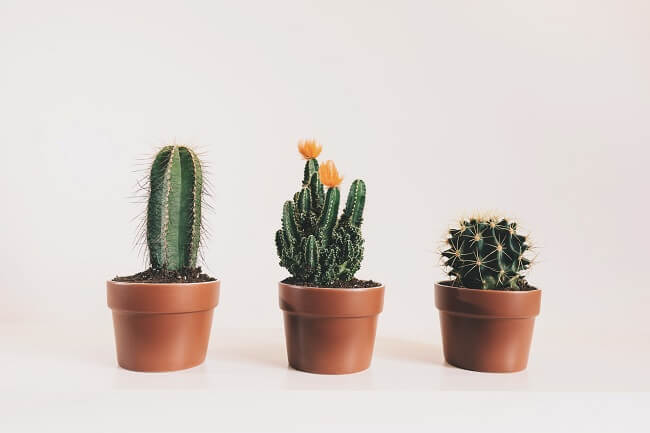Our Top 11 Picks For The Best Indoor Succulents And Cacti
Table of Contents
In recent years there has been a boom of interest in indoor succulents and indoor cactus plants, and for good reason. These little guys are tough by their very nature, and are a perfect match for someone who has a hard time keeping their indoor plants alive and remembering a regular watering schedule. But these little plants are not just tough – they are also beautiful. Succulents come in a variety of colors, textures, and sizes, and each type has its own unique characteristics. There are thousands of types of succulents and cacti hailing from the arid and semi-arid regions on every continent except Antarctica. Thinking of adding a few indoor succulents or cacti to your indoor plant collection? We’ve put together a list of our favorites, along with a few basic care tips and a bit of background info on each plant to help you find the right one for you!
String of Pearls (Senecio rowleyanus)
This aptly-named succulent hails from the dry regions of southwest Africa. In its natural habitat it crawls along the ground, sending its tendrils out and expanding. Indoors, however, this beautiful plant makes for a great hanging plant, with its elegant vines hanging gracefully from its planter. The String of Pearls enjoy bright but indirect light, and regular watering approximately every 10-14 days. During the summer months these plants thrive in temperatures ranging from 70 to 80 degrees, while in the warmer months they prefer lower temperatures of around 55 to 60 degrees. Keep in well-draining cactus mix, and cut back watering in the winter to no more than once a month. With proper care, your String of Pearls may even reward you with its cream-colored pom-pom shaped flowers that smell of cinnamon!
Pincushion Cactus (Mammillaria spp.)
The Pincushion Cactus is a common indoor cactus, and a favorite for novice indoor succulent enthusiasts thanks to how low maintenance it is. The term Pincushion Cactus actually refers to a variety of cacti in the Mammillaria genus, and includes many individual species. Some of the more common varieties that are kept as indoor cactuses include Mammillaria zeilmanniana, Mammillaria bocasana, and Mammillaria petterssonii. The majority of the Mammillaria cacti are native to Mexico, and thrive in as much direct sunlight as you can give them. Keep in cactus potting mix, and water only once the soil has dried from the previous watering. The Pincushion Cactus blooms in spring, and produces a crown of flowers ranging from pink to white, depending on the particular variety.
Panda Plant (Kalanchoe tomentosa)
This adorable fuzzy succulent is a native of Madagascar, and has become a favorite among succulent enthusiasts due to its unique look and ease of care. Sometimes referred to as the chocolate soldier or cocoon plant, this succulent should be kept in well-draining potting mix. It prefers indirect sunlight and medium lighting conditions, but avoid too much direct sunlight as it can scorch the leaves. Like most succulents, the Panda Plant should only be watered when its soil has completely dried from the previous watering. The Panda Plant is quite easy to care for, and won’t mind if you forget to water it for a week or two. In the winter, when the plant is dormant, cut down watering to once a month at most. It has no special humidity requirements, and does well in indoor environments.
Burro’s Tail (Sedum morganianum)
With its light blueish green leaves and trailing tendrils, the Burro’s tail is a striking native of southern Mexico and Honduras. It’s a common indoor succulent, often kept in hanging planters to allow its trailing stems to gracefully hang downward. It does best in direct sunlight, and should be watered once monthly in the summer, and even less in the winter. Make sure the soil has completely dried before you water your Burro’s Tail again, as this succulent is very prone to root rot. Keep in well-draining cactus potting mix, and ensure that excess water drains completely after each watering. With proper care, this succulent (also known as Donkey’s Tail) will reward you with its beautiful flowers that range from bright red to pink, depending on the specific cultivar.
Echeveria (Echeveria spp.)
Another common indoor succulent, the Echeveria is a hardy plant native to North and Central America. Echeveria is actually a genus that includes many varieties, each with its own unique coloration and characteristics. The most common variety is the Echeveria Perle von Nurnberg, a hybridized Echeveria that develops a rich pink color on the tips of its leaves when provided with ample sunlight. These succulents require very little water, and should be watered approximately once a month and only if their soil has dried completely from the previous watering. Keep in a well-draining planter filled with cactus potting mix, water infrequently, and enjoy your beautiful low-maintenance succulent!
Jade Plant (Crassula ovata)
The Jade Plant, also known as the Money Plant, is a common indoor succulent native to South Africa and Mozambique. They are widely regarded as a symbol of good luck, and are very easy to care for. Jade Plants prefer full direct sunlight, but will adapt to lower light conditions as well. During the spring and summer, when the plant is growing, provide your Jade Plant with regular watering. Allow the soil to mostly dry out between watering during these months, but cut back on watering during winter when the plant is dormant. They prefer well-draining cactus potting mix, and should never be left to sit in water as they are prone to root rot. They take well to indoor temperatures and humidity, but are susceptible to cold. Keep in a warm spot in your home where you can be sure that the temperature won’t drop below 50 degrees.
Zebra Cactus (Haworthiopsis fasciata/Haworthiopsis attenuata)
The Zebra Cactus is a unique and almost alien looking native to South Africa. They are closely related to Aloe Vera, being from the same family (Asphodeloideae), and have a somewhat similar appearance. As opposed to most succulents, the Zebra Cactus prefers indirect sunlight combined with some hours of shade, and but will adjust to almost all lighting conditions. Keep in well-draining cactus mix, water only when the soil is completely dry, and avoid watering your Zebra Cactus directly as this could cause root rot. Instead, water around the plant, completely soaking the surrounding soil. These succulents do well in standard indoor humidity, and are not susceptible to dry air. H. fasciata is the more common variety, with smooth inner leaves, with H. attenuate being less common and featuring ridges on the inner part of the leaf as well as the outer part.
Aloe Vera (Aloe vera)
The commonly known Aloe Vera plant is one of the few plants that is widely known by its scientific name. It is native to the Arabian Peninsula, and has been cultivated for centuries for its skin-soothing properties. Aloe Vera plants prefer temperatures ranging from 50 to 80 degrees, and do well in bright indirect sunlight. Keep in well-draining cactus mix, soak the soil through when watering, and allow the top few inches of soil to dry completely between waterings. If possible, keep your Aloe Vera plant in a terra cotta planter, as terra cotta allows moisture to dissipate more easily and helps prevent root rot from taking hold. You can use the gel stored in the leaves of the plant to soothe burns and other types of skin irritation, but know that the plant is toxic when ingested and should be kept away from pets and small children.
Lithops (Lithops spp.)
Also known as “Living Rocks”, these odd-looking succulents evolved to resemble stones in the arid regions of Namibia and South Africa. There are many varieties of Lithops, each with its own unique coloring and characteristics. These succulents are slow and low growing, and do best in at least 4 to 5 hours of direct sunlight. If their light requirements aren’t met, these little succulents can lose their characteristic patterns. Lithops are very hardy plants, and should be kept in well-draining cactus potting mix and watered sparingly. Lithops bloom in late autumn to early winter, and produce flowers in colors ranging from white to yellow to orange.
Old Man Cactus (Cephalocereus senilis)
Looking something like a bearded old man, the aptly-named Old Man Cactus is a native of eastern Mexico. Its hairy layer is called a “tomentum”, and serves to protect the cactus from the harsh sun and intense heat in its natural environment. These cacti require a minimum of 4 to 6 hours of direct sunlight a day to thrive, and should be kept in well-draining cactus mix and terra cotta planters if possible, as they allow water to evaporate more easily than plastic or glazed planters. Water sparingly during the spring and summer, when the cactus is growing, allowing at least the top few inches of soil to dry completely before watering again. In the winter, reduce watering to once every two months, and ensure your cactus is never left to sit in a pool of water as this can cause root rot.
Angel Wings Cactus (Opuntia microdasys var. albispina)
This almost cartoonish-looking cactus is another Mexico native, and is a favorite of cactus enthusiasts young and old alike. The Angle Wings Cactus, also lovingly known as “Bunny Ears”, is an easy-to-care for cactus with a unique look. They grow slowly indoors, and prefer dry environments combined with infrequent watering. Keep in well-draining soil, and provide at least 4 to 6 hours of direct sunlight daily. Soak the soil completely with each watering, and allow the soil to dry before watering again. Minimize watering in the winter to avoid overwatering the plant. The Angel Wings Cactus flowers in the summer months, producing soft-yellow colored flowers.

